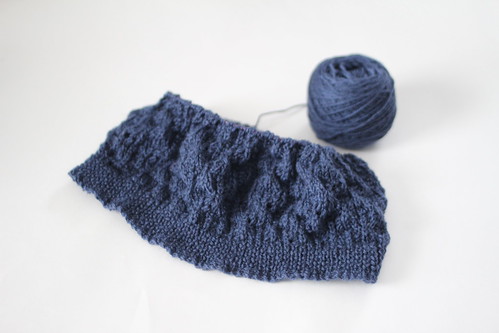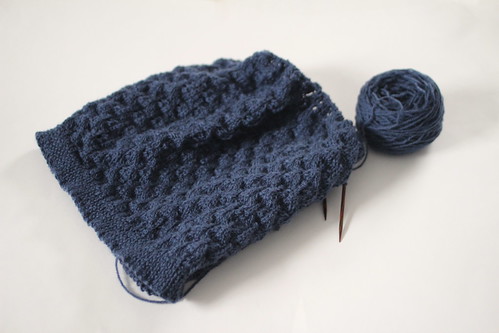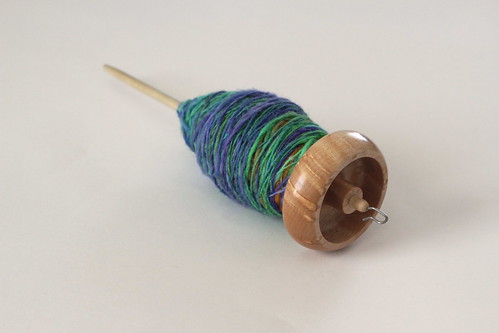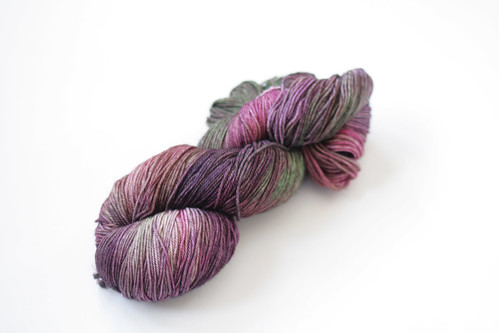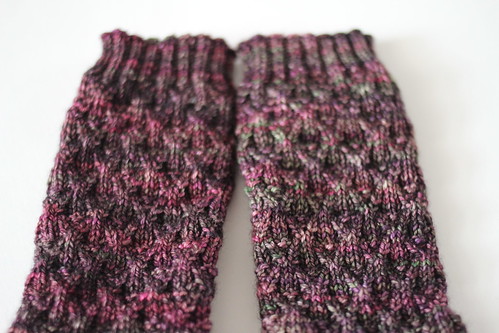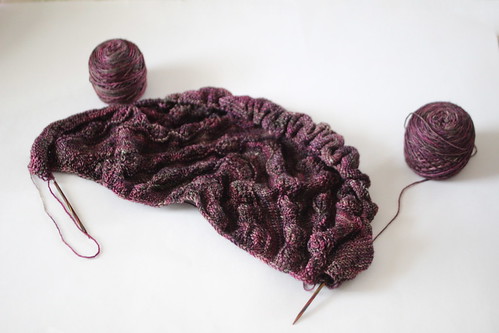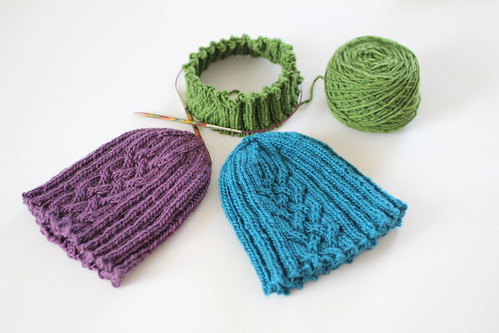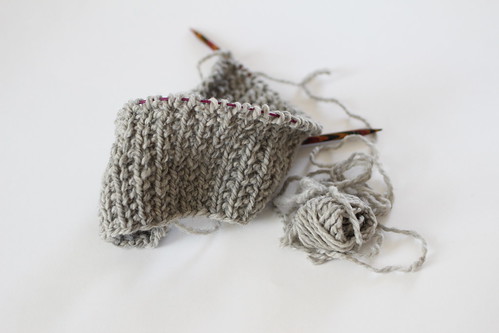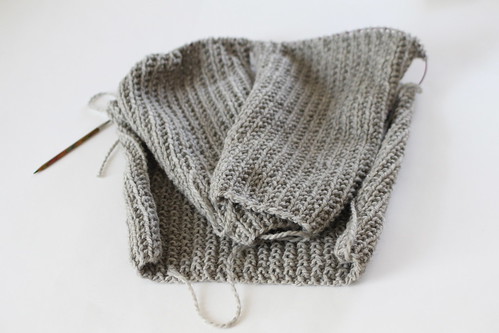Generally when a tech editor works for a magazine, a complete pattern is submitted by the designer. The technical editor’s responsibility is mainly to put the pattern into the magazine’s format, draw the schematics according to the magazine’s standards, and double check the numbers. If there are charts, they are usually already created when the pattern is submitted, and again, it’s just a matter of putting the charts into the magazine format.
When working with independent designers, however, there are opportunities to become far more involved the the process as the technical editor. Rather than just checking things to see if they are correct when all is said and done, the technical editor may play an integral role in taking an idea and figuring out how to make it work.
In many ways, when Alana and I work together, she is the architectural designer with the brilliant ideas, and I am the engineer who works on the details of transforming those ideas into patterns for other knitters to follow.
Accessories – hats, shawls, socks and the like – usually have one size. Alana knits up the sample and takes copious notes of what she did, row by row.
Then I get the pattern. I take Alana’s notes and create a chart. Not the finished chart – just a rough draft created in Excel using whatever symbols I am able to improvise. I decide what should be included in the chart and what shouldn’t be. I remove the text from the pattern that is part of the chart and re-write the pattern to incorporate the chart.
We send the chart to the graphic designer. Decisions are made as to what symbols should be used, where repeat lines should go, how to handle changes in marker position, and so forth. Our graphic designer, Mary Joy, is great because she is a knitter/designer herself and understands what we are trying to do (rather than being someone who is moving these foreign symbols around for these two women who can’t decide how things should be arranged). Mary Joy keeps a file of standard symbols used in Alana’s patterns and gives us valuable input based on how we’ve done things in previous patterns.
Once all that is done, the pattern is at a point where it is ready for a second technical editor – another pair of eyes to make sure everything is okay. The second technical editor plays the role more like that of the typical magazine technical editor, double checking everything that has been done and giving feedback on anything we may have missed.
Sweaters are even more involved than accessories.
Alana will send me an email with the gauge, the style (raglan, fitted, etc.), the sample size, and any stitch pattern constraints (such as a multiple of 10+11 for the patterned portions of Autumn’s End). I will take those specifications and give her key numbers for her to work with – stitch counts for the chest, upper arm, crossback, back neck width, shoulders, etc. Alana then knits up the sample, taking copious notes as she goes.
When I get the pattern, I decide what needs to be charted, just as with accessories. But with a sweater pattern, there is more.
Once the charts are created, I go on to grade the pattern for a whole range of sizes, doing everything I can to retain the look and feel of the sample size. Sometimes this requires modifications of the charts, such as with Twigs and Willows where we added extra leaves for the sizes on the higher end of the range. Sometimes that requires determining the design features upon which a design will hinge. For instance, Autumn’s End is knit from the bottom up but had to be graded from the top down in order to retain the look of the neckline across the sizes.
At that point, the sweater pattern is ready for the second technical editor. In addition, all patterns – sweaters and accessories – go to a sample knitter (or two) for additional testing and feedback.
Usually I am just involved in the technical editing, but on this project, I got to knit one of the samples as well. That’s a whole story of its own.
Knitting a sample isn’t like just knitting something for yourself. It’s a whole different experience. You have to actually follow the pattern (ha! ha!).
Seriously…if the designer says to work a ssk at the beginning of the row and a k2tog at the end, you have to do it that way even if you might do it differently if you were knitting this item for yourself. On the other hand, you get to just follow the pattern – there is no modifying the length or the waist shaping to make it fit your body. But if you mess up and do something wrong, you can’t just call it a “design feature” and keep going – you have to frog back and correct it…because it is a sample, after all.
This is the point at which everything turns into a three-ring circus. The second technical editor is making changes and comments that need to be reviewed. The test knitters are sending in feedback that needs to be addressed. And there are consistency edits to think about. Do we tell the knitter when to cut the yarn? Do we say “cut yarn” or “break yarn”? Is that part of the main pattern or the finishing portion? Those types of things are discussed and debated seemingly ad nauseam.
But at some point it all comes together and things are in pretty good shape. Then it is time for the whole project to go to the graphic designer to be prettied up. Seeing all the patterns go from Word doc format to the beautiful designs in the final book is like ordering yarn online and then seeing it in person when it arrives. There is no comparison.
Yet there is still work to be done. We have to check to make sure all of the pattern text is in the pdf document, that the charts were placed correctly, that everything is formatted correctly, etc. We try to have everything in order as much as possible before things go to the graphic designer, but there are still changes. Lots of changes. It’s a good thing the pdf is so beautiful because otherwise I might get tired of looking at it!
And still there are things that get missed that knitters discover once the pdf version is released. We scramble to review each of the questions and make any necessary changes. As I review these types of changes, I always go back and look through the various drafts see who changed what in order to discover how the error made it into the document. I go back to my original numbers to see if I had a formula wrong in my original Excel worksheet. For every error a knitter points out, I try to figure out what went wrong so we can learn from our mistakes.
Every technical editor will tell you that if they designed something, even though they are a technical editor, they would have someone else review it. As technical editors, we find and correct lots of mistakes, but still there are always a few that manage to slip through. We are human, after all.
I work with many designers, and my part in the process is different with every one. I love working with independent designers for that reason – there is so much variety. Sometimes I’m just checking things while on other projects, I am an integral part of the creative process. So many different perspectives helps me be a more well-rounded editor. Or so I hope.
Alana’s newest book – Botanical Knits – is now available for preorder for $22 + shipping. As a special thank you for preordering the printed copy, you will get the ebook for free immediately. The printed book will ship mid-May. For those who preorder the book, it will ship with an exclusive extra botanically inspired garment pattern as a thank you from Alana for preordering.
Or you can just order the ebook by itself for $18. This is a great option for those knitters who live internationally and do not want to pay the high cost of shipping.
After the pre-order period ends in May, the book will be available EITHER in print for $22 or ebook for $18. There will be no digital and print bundle offered.
My advice? Order your copy today! If you knit, your biggest problem will be deciding which project to start first. And if you don’t knit, you will still want this book for your coffee table.
